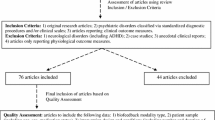Abstract
Five papers by Peniston and colleagues, which constitute the basic literature for alpha-theta EEG biofeedback treatment for alcoholism and posttraumatic stress disorder, are reviewed. As a result, we raise three questions: (a) Are the samples studied independent? (b) What was the clinical status of the participants prior to treatment? (c) What treatment did the participants actually receive? In seeking answers to these questions we aim to strengthen the database for neurofeedback with specific procedural information so that claims of efficacy can be tested and accepted or rejected on an objective basis.
Similar content being viewed by others
REFERENCES
American Psychiatric Association. (1980). Diagnostic and statistical manual of mental disorders (3rd ed.). Washington, DC: Author.
American Psychiatric Association. (1994). Diagnostic and statistical manual of mental disorders (4th ed.). Washington, DC: Author.
Beck, A. T., Ward, C. H., Mendelson, M., Mock, J., & Erbaugh, J. (1961). An inventory for measuring depression. Archives of General Psychiatry, 4, 561–571.
Escobar, J. I., Randolph, E. T., Puente, G., Spiwak, J. K., Asamen, M., Hill, & Hough, R. L. (1983). Posttraumatic stress disorder in Hispanic Vietnam veterans: Clinical phenomenology and sociocultural characteristics. Journal of Nervous and Mental Disease, 171, 585–596.
Hathaway, S. R., & McKinley, J. C. (1943). Booklet for the Minnesota Multiphasic Personality Inventory. New York: Psychological Corporation.
Keane, T. M., & Wolfe, J. (1990). Comorbidity in post traumatic stress disorder: An analysis of community and clinical studies. The Journal of Applied Social Psychology, 20, 1776–1788.
Millon, T. (1983). Millon Clinical Multiaxial Inventory (3rd ed.). Minneapolis, MN: National Computer Systems.
Peniston, E. G. (1986). EMG biofeedback-assisted desensitization treatment for Vietnam combat veterans post-traumatic stress disorder. Clinical Biofeedback and Health, 9, 35–41.
Peniston, E. G., & Kulkosky, P. J. (1989). Alpha-theta brainwave training and beta endorphin levels in alcoholics. Alcoholism: Clinical and Experimental Research, 13, 271–279.
Peniston, E. G., & Kulkosky, P. J. (1990). Alcoholic personality and alpha-theta brainwave training. Medical Psychotherapy, 3, 37–55.
Peniston, E. G., & Kulkosky, P. J. (1991). Alpha-theta brainwave neurofeedback for Vietnam veterans with combat related post-traumatic stress disorder. Medical Psychotherapy, 4, 47–60.
Peniston, E. G., Marrinan, D. A., Deming W. A., & Kulkosky, P. J. (1993). EEG alpha-theta brainwave synchronization in Vietnam theater veterans with combat related post-traumatic stress disorder and alcohol abuse. Advances in Medical Psychotherapy: An International Journal, 6, 37–50.
Wolpe, J. (1958). Psychotherapy by reciprocal inhibition. Stanford: Stanford University Press.
Author information
Authors and Affiliations
Rights and permissions
About this article
Cite this article
Graap, K., Freides, D. Regarding the Database for the Peniston Alpha-Theta EEG Biofeedback Protocol. Appl Psychophysiol Biofeedback 23, 265–272 (1998). https://doi.org/10.1023/A:1022265716026
Issue Date:
DOI: https://doi.org/10.1023/A:1022265716026




